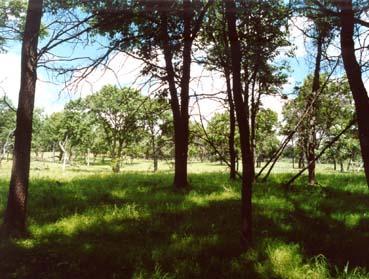
Funded by: Long Term Ecological Research
Our long-term studies at Cedar Creek were begun in 1982 with the funding of our LTER proposal by the National Science Foundation. Prescribed burning is a commonly accepted tool for managing and/or restoring temperate oak savannas and tall-grass prairie. Studies in oak and pine savannas suggest that high frequency prescribed burns are effective in suppressing understory shrubs and trees and in promoting increases in grasses and forbs. In the 1960s, Cedar Creek scientists started one of the earliest and longest-running experiments on fire and fire suppression in forest ecosystems.
In the Midwest, oak savannas were once abundant, and in Minnesota 200 years ago, oak savanna made up approximately 10% of the native vegetation. Oak savanna is a fire dependent ecosystem; the thick bark of bur oaks (Q. macrocarpa) protect them from fire, and prairie grasses are adapted to survive after fire. When European settlers suppressed fires, and farming and development reduced the oak savanna ecosystem, intact oak savannas became one of the rarest ecosystems on earth.
Our research involving oak savanna and fire is conducted at the Cedar Creek Ecosystem Science Reserve. The reserve is located in the transitional zone between tall grass prairie and temperate deciduous forest, or prairie/forest border. Northern pin oak (Quercus ellipsoidalis) and bur oak are dominant tree species.
Results of our studies have shed light on the way forests and prairies develop and have helped clarify the global carbon cycle.
Publications
Frelich, L.E., P.B. Reich, D.W. Peterson. 2015. Fire in Upper Midwestern Oak Forest Ecosystems: an Oak Forest Restoration and Management Handbook. USDA Forest Service General Technical Report PNW-GTR-914
Wright, A., S.A. Schnitzer, P.B. Reich. 2014. Living close to your neighbors – the importance of both competition and facilitation in plant communities. Ecology 95:2213–2223
Cavender-Bares, J., P.B. Reich. 2012. Shocks to the system: Community assembly of the oak savanna in a 40-year fire frequency experiment. Ecology doi: http://dx.doi.org/10.1890/11-0502.1.
Norris, M.D., P.B. Reich. 2009. Modest enhancement of nitrogen conservation via retranslocation in response to gradients in N supply and leaf N status. Plant and Soil 316:193-204.
Peterson, D.W., P.B. Reich, K.J. Wrage. 2007. Plant functional group responses to fire frequency and tree canopy cover gradients in oak savannas and woodland. Journal of Vegetation Science 18:3-12.
Dickie, I.A., S.A. Schnitzer, P.B. Reich, S.E. Hobbie. 2007. Is oak establishment in old-fields and savanna openings context dependent?Journal of Ecology 95:309-320.
Dijkstra, F.A., K. Wrage, S.E. Hobbie, P.B. Reich. 2006. Tree Patches Show Greater N Losses but Maintain Higher Soil N Availability than Grassland Patches in a Frequently Burned Oak Savanna. Ecosystems 9:441-452.
Johansson, P., Reich, P.B. 2005. Population size and fire intensity determine post-fire abundance in grassland lichens. Applied Vegetation Science 8:193-198.
Peterson, D., P.B. Reich. 2001. Prescribed Fire in Oak Savanna: Fire frequency effects on stand structure and dynamics. Ecological Applications 11(3):914-927.
Reich, P.B., D.A. Peterson, K. Wrage, D. Wedin. 2001. Fire and vegetation effects on productivity and nitrogen cycling across a forest-grassland continuum. Ecology 82:1703-1719.
Tilman, D., P. Reich, H. Phillips, M. Menton, A. Patel, E. Vos, D. Peterson, J. Knops. 2000. Fire suppression and ecosystem carbon storage. Ecology 81:2680-2685.